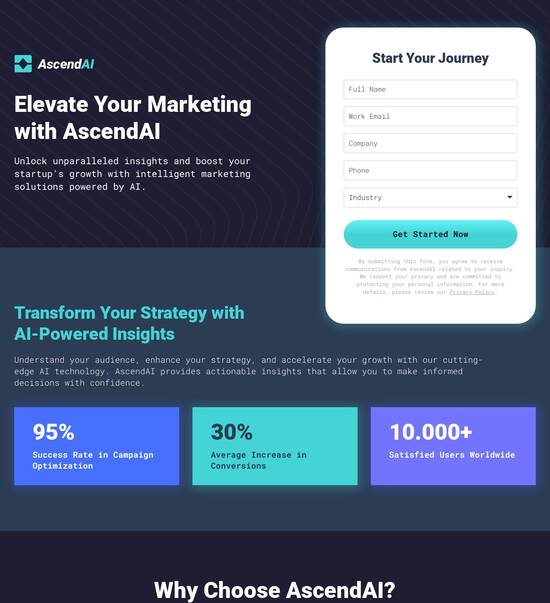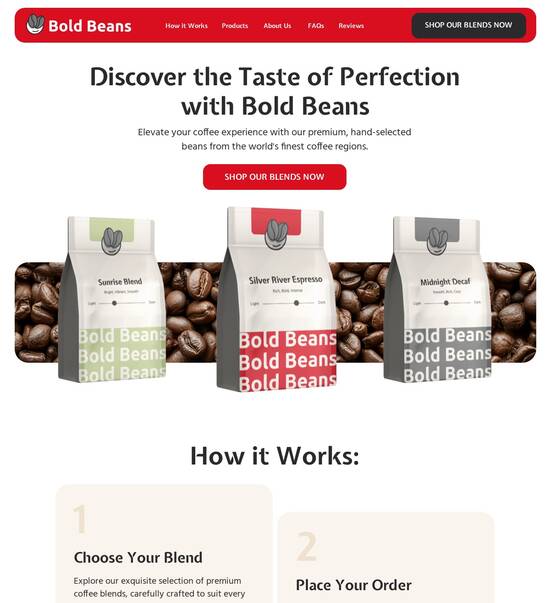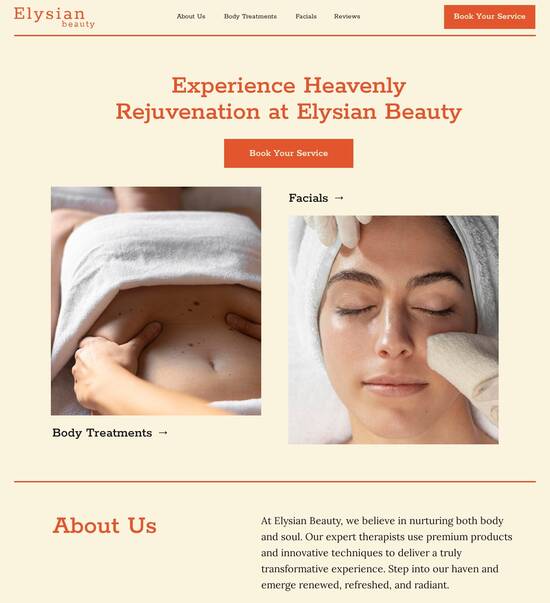
Web page template for Hotel front desk agents
Use TemplateAbout template
Attract clients and showcase your skills with style using our landing page templates for Hotel front desk agents. Let's convert those visitors into clients!
Recommended templates

Easy to build without coding
With the intuitive drag-and-drop builder, anyone on your team can create high-converting pages without any knowledge of code or design. Make enhancements to your landing page with custom widgets using Javascript, HTML/CSS, or third-party scripts.

Multiple layouts for any industry and goal
Select from 500+ landing page layouts built to boost conversions across industry-specific scenarios. Customize them by adjusting fonts, adding images, and generating on-brand content with the AI assistant. Quickly scale with Instablocks® and Global Blocks that you can save, reuse, and update globally.

Loads fast and looks polished on any device
Every template is responsive, which means they present professionally on any device and load blazingly fast with our Thor Render Engine. You can also power them up with Google AMP technology to deliver an unparalleled mobile experience and drive higher conversions.

Robust analytics & experimentation
Get real-time updates and reporting across all your devices, showing the number of visitors, conversions, cost-per-visitor, and cost-per-lead. Launch AI-powered experiments, run A/B tests, and use heatmaps to analyze user behavior, then optimize your landing page to maximize conversions.







Easy to build without coding
With the intuitive drag-and-drop builder, anyone on your team can create high-converting pages without any knowledge of code or design. Make enhancements to your landing page with custom widgets using Javascript, HTML/CSS, or third-party scripts.
Multiple layouts for any industry and goal
Select from 500+ landing page layouts built to boost conversions across industry-specific scenarios. Customize them by adjusting fonts, adding images, and generating on-brand content with the AI assistant. Quickly scale with Instablocks® and Global Blocks that you can save, reuse, and update globally.
Loads fast and looks polished on any device
Every template is responsive, which means they present professionally on any device and load blazingly fast with our Thor Render Engine.
Robust analytics & experimentation
Get real-time updates and reporting across all your devices, showing the number of visitors, conversions, cost-per-visitor, and cost-per-lead. Launch AI-powered experiments, run A/B tests, and use heatmaps to analyze user behavior, then optimize your landing page to maximize conversions.
All the features you need to build summary of the book front desk
Explore more featuresLearn how to build front desk book summary
FAQs
Leading the way in building high-performing landing pages





An essential guide to creating landing pages with Instapage
Instapage serves as a powerful ally for marketers aiming to supercharge their digital campaigns. In this guide, we'll delve into how to effectively utilize Instapage's capabilities to create high-converting landing pages that maximize return on investment.
Understanding Instapage's benefits
Harnessing the features of Instapage enables you to design landing pages tailored to your marketing needs. From extensive library access to design flexibility, Instapage streamlines the process of creating unique, conversion-focused content. Consider why this platform is the go-to choice for marketers across various sectors, including business services and education.
- Wide array of templates: Choose from over 100 customizable templates that suit diverse marketing goals.
- Integration capabilities: Seamlessly connect your pages with marketing tools, ensuring every element works together for peak performance.
- A/B testing facility: Utilize built-in A/B testing tools to refine your pages based on real user behavior.
Step 1: Select the right template
Begin by selecting a template that aligns with your campaign objectives. Instapage's template collection includes options constructed for various business sectors including tech and finance. Ensure you pick a layout that speaks to your target audience's needs.
Step 2: Customize for your audience
After selecting a template, the next step is customization. Focus on elements that resonate with your specific audience—this can include tailored text and engaging visuals. Consider creating dynamic content that's adaptable for varying audience segments.
- Dynamic text replacement: Swap out text based on visitor behavior or sourcing to enhance relevancy.
- AdMaps: Align specific ads to dedicated landing pages for enhanced audience suitability.
- Analytics tracking: Measure engagement and conversion metrics at an in-depth level.
Step 3: Optimize for performance
Finally, regular optimization of your landing pages is vital. Leverage the analytics and heatmap features to understand how users interact with your content, and apply this data to conduct effective A/B tests. Aim for continuous iteration to maintain and improve performance.
- Conduct user behavior analysis via heatmaps to pinpoint engagement hotspots.
- Perform regular A/B tests on CTA placements and color schemes to determine the most effective combinations.
- Utilize feedback from real users to make data-driven decisions on page adjustments.
In conclusion, mastering the nuances of digital marketing through powerful tools like Instapage can lead to substantial growth in campaign performance and ROI.
Ready to elevate your marketing game? Explore how Instapage can transform your digital strategies today!
People also ask about Web page template for Hotel front desk agents
Web page template for hotel front desk agents
Understanding the necessity of a tailored hotel landing page template
The hospitality industry has witnessed an evolution in the role of hotel front desk agents. Traditionally seen as mere information providers or point-of-contact personnel, these agents now embody the first impression of a hotel experience. From check-in processes to handling inquiries, they have a multifaceted role that extends into digital avenues. As customers often connect with hotels online before setting foot in the establishment, a well-structured landing page acts as an extended front desk, setting the tone for what guests can anticipate.
In a competitive market, first impressions are paramount; a clean, efficient digital interface can captivate visitors and guide them in their decision-making process. The landing page must not only reflect the hotel's brand identity but also enhance the overall guest experience, ensuring potential guests feel welcomed even before their arrival.
Challenges faced by front desk agents
Front desk agents encounter various challenges that can hinder their effectiveness. Time constraints are prevalent; the flurry of check-ins, check-outs, and guest inquiries often leaves little room for personalized communication. To combat this, efficiency in workflows is critical. A landing page tailored for hotel operations can minimize repetitive tasks, such as answering FAQs or updating guests about amenities, thereby freeing agents to focus on enhancing the guest experience.
Moreover, striking a balance between personalization and operational efficiency is a significant challenge. Guests appreciate tailored services, yet agents must also ensure that these services do not slow down hotel operations. A smart landing page template can integrate automated responses and provide essential details upfront, allowing agents to forge meaningful connections with guests without compromising efficiency.
Why a specialized hotel landing page template is essential
Understanding guest expectations in the digital landscape is crucial for hotels. Today's travelers expect intuitive and streamlined experiences when browsing accommodations online. This extends beyond aesthetic appeal; usability is a key factor influencing their choice. An engaging landing page designed specifically for hotel front desks can present relevant information quickly and clearly, guiding users toward booking without overwhelming them with confusing layouts.
User experience (UX) dramatically impacts booking behaviors. Research shows that a well-designed landing page that prioritizes user-friendliness can significantly improve conversion rates. As front desk agents play a pivotal role in shaping guest experiences, their work can be supported by an effectively designed website that not only represents the hotel well but also streamlines core functions.
Key features of hotel page templates
Creating a seamless user experience for potential guests hinges on the structural interplay of HTML and CSS. These foundational coding languages work together to develop visually compelling layouts that are functional as well as aesthetic. HTML establishes the skeleton of a webpage, while CSS adds style and ensures the site appears professional and aligned with the hotel's brand image.
Responsive design is another essential feature of hotel web pages. In a world where mobile devices dominate, ensuring that a landing page functions flawlessly across various screen sizes is non-negotiable. A responsive layout ensures guests can access hotel information, amenities, and booking options from their smartphones or tablets, resulting in a smooth user experience regardless of the device.
Integration with booking systems
The integration of booking systems directly into hotel landing pages is a critical feature that enhances operational efficiency. Direct booking functionalities allow guests to reserve rooms promptly, reducing the need for potential guests to navigate away from the page or seek additional information via phone. By having an integrated booking engine, hotels increase the chances of conversion, providing guests with a straightforward path from interest to action.
Several booking system integrations are common in the hospitality industry, including APIs that connect to major global distribution systems (GDS). By presenting real-time availability and rates, hotels can dynamically adjust their offerings to attract potential customers, making the booking process as frictionless as possible.
Incorporating dining options and amenities
Highlighting dining options and other amenities directly within the hotel’s landing page template can enhance the guest’s decision-making process. A dedicated section for restaurants showcases the culinary offerings of the establishment, enticing visitors with mouth-watering descriptions and high-quality images. Featuring special promotions or unique dining experiences can further drive interest, as guests appreciate knowing their options before making a reservation.
Additionally, presenting amenities clearly and attractively is vital. Visitors want to see what sets a hotel apart, whether it's a luxurious pool, gym facilities, or a spa. With proper categorization and engaging visuals, guests can easily discern what amenities resonate with their preferences, thereby increasing the likelihood of booking.
Innovative design elements in hotel templates
A hotel's landing page must not only convey necessary information but also serve as an aesthetically pleasing artifact. Crafting visually stunning hotel templates involves adhering to design principles specifically tailored for the hospitality industry. High-quality images are paramount—showcasing rooms, facilities, and surroundings effectively attract and retain visitors. Moreover, clear typography ensures that text is easily digestible, emphasizing key messages without overwhelming the reader.
As technology advances, utilizing AI for personalized template designs represents a promising frontier. AI applications can analyze guest behavior and preferences to customize web experiences dynamically. By predicting what guests might like based on their interactions, hotels can offer tailored content and recommendations, leading to more engaging interactions that enhance customer satisfaction.
Functional capabilities of a hotel landing page template
Enhancing user engagement hinges on incorporating essential functions into the hotel landing page template. Interactive elements such as chatbots and contact forms provide guests with immediate support, addressing inquiries as they arise. This creates an inviting atmosphere for guests, making them feel valued and heard. Furthermore, navigation features that simplify the guest's journey—from landing on the page to completing their booking—are critical in retaining visitors and reducing bounce rates.
Showcasing hotel features at a glance is another effective strategy. Utilizing design principles that favor quick visual information delivery can help communicate the essential offerings to potential guests clearly and attractively. Infographics and concise text serve as tools to present complex information in an easily digestible format, helping visitors make informed decisions promptly.
The benefits of a specialized hotel front desk page template
Specialized hotel front desk page templates can significantly streamline operations for agents. By optimizing landing pages to reduce their workload, these templates allow agents to dedicate more attention to personalized service. Integrating backend functionalities connects the landing page to internal systems, thereby organizing operations seamlessly and enhancing overall efficiency.
Moreover, a well-designed page can boost conversion rates. Effective design directly impacts booking statistics, with clear calls-to-action and engaging layouts encouraging guests to follow through on reservations. Examining case studies of successful hotels reveals that those having tailored landing pages see a noticeable uptick in conversions, demonstrating the value of investing in specialized templates.
Enhancing visitor experience through tailored features
For a hotel landing page to be effective, it must prioritize the visitor's experience. Mobile optimization is crucial, as many guests browse and book on the go. A mobile-friendly design ensures greater accessibility, capturing the on-the-fence guests who prefer quick reservations. Additionally, leveraging social proof—such as dynamically showcasing reviews and testimonials—can enhance credibility and boost engagement, creating a relatable and trustworthy digital atmosphere.
Implementing dynamic content based on user behavior is another innovative strategy for re-engagement. This approach personalizes user experiences, as returning visitors receive tailored communications or offers based on their previous interactions. Employing email capture strategies can encourage guests to revisit the site or consider promotions, enhancing overall booking potential.
Holistic overview of adaptable hotel templates
Scalability is a notable feature of hotel templates, allowing hotels of varying sizes and types to customize their approach. Boutique hotels might prioritize unique design elements that reflect their character, while large chains often require templates that accommodate vast inventories seamlessly. This flexibility enables properties to adjust features and content according to seasonal promotions, special events, or changes in guest expectations, maximizing the effectiveness of their digital presence.
Future trends in hotel web page design indicate a shift toward greater interactivity and personalization. Technologies such as augmented reality and voice commands promise to alter how guests engage with hotel websites. Keeping an eye on these advancements is essential for hotels wanting to remain competitive, as new elements will continuously reshape expectations within the hospitality sector.
Implementation insights for front desk agents and managers
Setting up a hotel landing page template requires a thoughtful approach, encompassing everything from conceptualization to execution. A step-by-step guide can assist front desk agents and managers in visualizing this process. Engaging with web designers early can foster collaboration, ensuring that the design aligns with operational needs while also reflecting the hotel's branding effectively.
Evaluating the success of a template is equally important. Key metrics to monitor include bounce rates, conversion rates, and guest feedback, providing insight into areas requiring adjustment or enhancement. Regularly assessing website analytics allows for iterative improvements, continually refining the user experience and ultimately driving greater engagement and conversions.
Ready to skyrocket conversions?
Supercharge your ad campaigns with high-performing landing pages
Get started














